Chris Baty's Blog, page 73
October 3, 2019
How to Reinforce Your Characters with Detailed WorldbuildingWhat...
How to Reinforce Your Characters with Detailed Worldbuilding
What does the world of your novel look like? Sometimes you have a great story idea, or really cool characters, but for some reason, your writing just seems to fall flat. Watch this video to get some tips on how detailed world-building can help you add depth to your characters and your plot.
If you don’t include a lot of detail when you’re creating the world of your story, your characters may seem two-dimensional.
One writing trick is to show more about your characters by putting them in specific settings and letting the objects or landscape around them tell readers something about the characters themselves.
You can also use your setting to enhance or create a specific mood in your novel, or alert your readers that an important plot point is about to happen. It can also influence how your readers feel when they’re reading your novel.
Treating your setting as something that shows how your characters feel, not just the place they happen to be in, can help deepen your writing and make your readers more invested in your story.
October 2, 2019
6 Tips for Worldbuilding on a Time Crunch

Every story needs a setting, but crafting a world can take time that some of us (through no fault of our own, I’m sure) just don’t have. In this post, Municipal Liaison Rebekah Loper walks you through a worldbuilding word sprint!
If there’s one thing my local Wrimos know about me, it’s that I love worldbuilding. I’m not talking about just enjoying it, but it’s one of my hobbies, even when I’m not actively worldbuilding for a specific story. But it’s not that captivating for everyone.One aspect of writing often overlooked is that the story setting is just as important as your characters. You might even say that the setting is a character in its own right, but especially so if your stories are set in fictional worlds.While worldbuilding can be daunting, there are some tricks to help you determine which elements of worldbuilding are most important to develop for your story, and these will even apply if you’re a pantser who doesn’t know much about your plot yet.
So go grab a notebook (or open up a document!) and let’s get started.
1. Set a timer.This is the same concept behind word sprints. If you give yourself a set time limit, you can focus right on the task at hand. Start with 10 minutes per task below, but feel free to extend that time if you find you can focus longer. Feel free to start the timer over if you need more time to finish a section, but try not to spend more than 30 minutes total before moving on to the next one.
2. Start with your main character.This will help with any outlining you’re doing as well – who is your main character, what do they want, and why? What is important to them? What was the happiest moment of their life and/or the worst? Most importantly, how do they view themselves within their world.
3. Now that you know a little about your character, take a look at their cultural influences.This is equally as important as your character’s internal view of themselves, because outside influences often shape those views. It’s possible to break free of them in certain situations, but most of the time they will always remain a fundamental part of who they are, whether it affects them in positive or negative ways.
What were their surroundings like growing up? What are their favorite holidays? Did they have a coming of age ceremony or ritual to complete? Were they able to do so? What societal expectations weigh on their shoulders, whether those expectations are based on gender roles, vocation, or socioeconomic status? What if they are not able to accomplish any or some of those goals?
4. What does the world look like through your character’s eyes?Now that you’ve met your character and know some about their internal values and external influences, start taking a look at the world around them. Use the holidays, coming of age, and societal expectations that you may have explored in the previous task and branch off to explore more of the surrounding world. How have those things shaped not just your character, but the culture and society around them?
Additionally, what does their home look like? Their village, city, country? Desert, mountains, forest, coast, prairie?
As time allows, keep exploring your world as you expand its horizons. Look for the why behind a society’s actions, including access to natural resources (water, arable land, hunting grounds, etc.).
5. Now that you’ve explored your story setting and your character’s worldview, what potential for story conflict exists within your fictional world?Conflict is what makes your story interesting. As I said earlier, your setting is just as much a character as, well, your characters. It should enrich your story and raise the stakes. Those societal expectations you’ve started to explore may clash with the expectations of differing societies and cultures, for one. Conflict is always a potential when a character goes from one culture to another. Or, conversely, they may find they fit in better in another culture, and that can generate internal conflict!
6. The rest is just aesthetics!Seriously! While you do need to have some intentions behind why buildings, clothing, and even species might look certain ways (due to the natural resources and environment), it’s pretty much just frosting on the cake once you know the why of a society and culture. I recommend using Pinterest to collect any images that catch your interest, especially ones you just stumble on and it resonates with your world.
Any questions about worldbuilding? Just ask in the comments, and I’ll answer as soon as I can!
Also, you can sign up for my newsletter any time in September or October and get my Character Creation Chart for free!
Want to go even more in-depth with your worldbuilding? Find out more about my book, The A-Zs of Worldbuilding: Building a Fictional World From Scratch!

Rebekah Loper began creating fictional worlds and epic stories as a child and never stopped. Now she also helps inspire others to write their stories through her volunteer work as a NaNoWriMo Municipal Liaison, and with her workbook, The A-Zs of Worldbuilding: Building a Fictional World From Scratch. Her most recent release, a fantasy short story titled The Path of Mercy, is available in Beatitudes & Woes: A Speculative Fiction Anthology.
Rebekah lives in Tulsa, Oklahoma with her husband, a dog, two formerly feral cats, a flock of chickens, and an extensive tea collection. She is often found battling the elements in an effort to create a productive, permaculture urban homestead on a shoestring budget.
She blogs about writing and urban homesteading at rebekahloper.com, and has been a contributing writer for Fantasy-Faction.com. You can follow her on Facebook, Instagram, and Twitter.
Top image licensed under Creative Commons from ricardo on Flickr.
October 1, 2019
It’s October, which means that National Novel Writing Month is...

2019 NaNoWriMo Facebook Cover

2019 NaNoWriMo Writer Badge
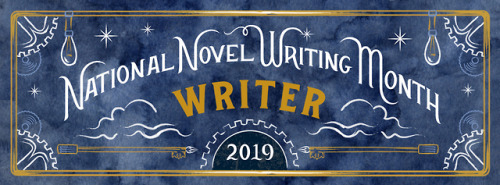
2019 NaNoWriMo Twitter Banner
It’s October, which means that National Novel Writing Month is just one month away!
Are you writing a novel with us in November? Let the world know by updating your social media profiles with this participant flair! (We have a square icon image, as well as banners sized for Facebook and Twitter).
You can also announce your project on the brand new NaNoWriMo website! If you haven’t seen it yet, log into nanowrimo.org with your existing username and password (or create a new one if you don’t have an account). You can go to “My NaNoWriMo” > “Projects”, and click the “Announce new project” button at the top.
Not sure what you want to write about yet? Don’t freak out! We’ve got a lot of resources to help you prep for writing a novel this month with our NaNo Prep 101 workbook and exercises.
September 30, 2019
A Quick Guide to Starting Your Novel

Every year, we’re lucky to have great sponsors for our nonprofit events. Today, Milanote, a 2019 NaNoWriMo sponsor, has partnered with creative writing coach Angel McCoy to bring you this summary guide on how to start your novel as you prepare for NaNoWriMo:
Writing a novel is the most amazing adventure you may ever undertake. It’s a baring of the soul, no matter how fictional. It requires dedication, attention to detail, imagination, and a burning desire to tell a story. When you sit down to begin your story outline, you’re taking the first step on a journey into the unknown. Fortunately, many novelists have already traveled the path before you, so you don’t have to go into that wilderness without a map.
Milanote is a wonderful creative writing app where you can organize your research, ideas, characters and outline in one place.
In this article you will learn five critical questions to ask yourself about your novel so that you can begin formulating a vision for it. These questions are practical and inspirational. This is the first step toward writing your novel, so let’s settle in and get started!
Question 1: What is this novel about?The first question is “What is this novel about?” At this stage, you don’t want to dive too deep. State your answer as a “What if…” question, and limit yourself to twenty words or less. These limitations help to refine your concept. See example below for The Wizard of Oz.
 Question 2: What are the stakes?
Question 2: What are the stakes?The next question is “What are the stakes?” If your heroes fail, what will happen? What do the world and your characters have to lose if this story ends in tragedy?
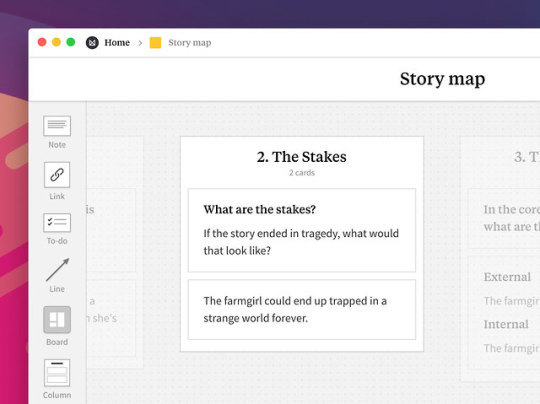 Question 3: What is the core conflict?
Question 3: What is the core conflict?After the stakes, you want to define the core conflict. A great way to express this is with an “X versus Y” statement, where X is your protagonist and Y is the force working against your protagonist. Who or what wants to keep the protagonist from achieving success? Is it an individual, a group, a situation, an internal struggle, or something else?
 Question 4: How is the conflict resolved?
Question 4: How is the conflict resolved?Eventually, the Core Conflict must be resolved, but how? When answering this next question, consider whether the protagonist fails or the story ends in success. Describe, in one sentence, how the Core Conflict is resolved.
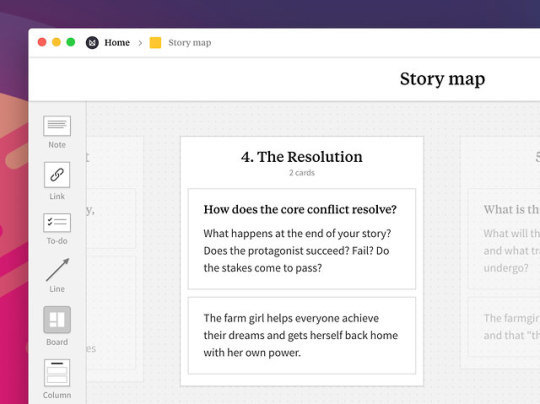 Question 5: What is ‘the lesson’?
Question 5: What is ‘the lesson’? Conflict creates change, whether in the protagonist or the world itself. A novel is the story of change through conflict. In your novel, what needs to change? We call this The Lesson to represent that someone or something is facing a trial that will end in transformation. What is the transformation that occurs through the course of your novel and comes to fruition through the application of the Core Conflict?

If you answered all these questions, then you’re well on your way to a novel.
If you found this guide useful you might like to try Milanote’s accompanying story map template to help you start your next great novel.

Angel Leigh McCoy tells tales and builds worlds for a living. Her stories have entertained millions, maybe even you. AngelMcCoy.com
September 27, 2019
Road Trip to NaNo: Character Inspiration Is All Around You
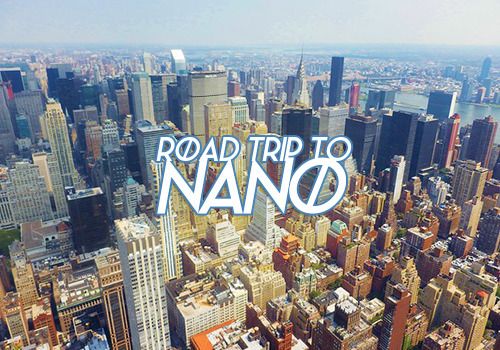
November is coming. To get ready, we’re taking a road trip to visit Wrimos from around the world, and hear about how their regions can inspire your writing. Today, New York City Municipal Liaison Kayleigh Webb talks about how the people around us can serve as inspiration:
New York City is so incredibly special because it encompasses so much. New York is sprawling, forming five different boroughs are home to the 8.6 million New Yorkers who walk the sidewalks and ride the subways every day. Each person with their own backstory, own lives, own likes, dislikes, and everything in between. Ghosts of the past peek between gleaming skyscrapers while forest green scaffolding is a reminder that the future is just a few blueprints away. Libraries and museums give endless access to the stories of the past, and every day stories are told on the stages of Broadway theatres.
Truman Capote, Alexander Hamilton, Edith Warton, Herman Melville, and Colson Whitehead are just a few of the many prolific writers that New York has fostered and each year, more writers are finding their craft through NaNoWriMo.
It’s the city that never sleeps, a city that never stops, and a city that taught me to write like I was running out of time. Prior to joining the New York City region of NaNoWriMo, I participated in NaNoWriMo in Mississippi, where I never successfully completed the coveted 50,000 words in the month of November. That changed the moment I sat down at my first write-in in New York. The creative spirit of the New York City region takes root deep in your bones and never lets you go.
In short: it’s a fantastic place to live if you are a writer.
Why? Because in New York City, inspiration is everywhere.
Often, I find my characters come to before the plot bunny really bites and leads me down the spiraling rabbit hole that is my plantser novel writing process. Those characters are the seeds that make the garden grow. They walk past me on the street, sit across from me on the subway. Characters are all around you, you just have to look! Living in New York is truly a character study.
To quote Sondheim’s musical Company:
It’s a city of strangers
Some come to work, some to play
A city of strangers
Some come to stare, some to stay
And every day…..
another hundred people just got off of the train.
But then again, every day of your life is a character study! You just have to open your eyes.
Now, I’m not asking you to stare at the next person you see and try to memorize them as they are so you can transpose them on the page EXACTLY as you saw them. First and foremost, people watch respectfully. Instead, think of the way the person walks, how they speak, the subtlety of their body language, the patches on the bright green backpack of a suited businessman whose Doctor Who key chain distracts you from the novel you’re reading during a subway delay.
Most recently, the pieces of a project I had been stuck on for months fell into place the moment a young man strode onto the subway and leaned against the subway pole. With one glance of disinterest around the train, he shifted his sunglasses over his eyes and the metaphorical light bulb above my head dinged. He didn’t care that he was blocking the railing for the rest of the train. He knew who he was and in that moment, he owned that space. Finally, I knew how my villain carried himself and the attitude in which he viewed the world. Never before was I glad I carried a notebook at all times.
So, I challenge you to go to a public place where you are most comfortable – be it a café, your daily bus route, or even the checkout line of Target. Who catches your eye? Why? What do you hear around you? Perhaps their hair curls in a way that sparks an idea for your hero or an overheard laugh instantly places you in the throne room of a fantasy novel, where an antagonist sits plotting your main character’s downfall. Build a backstory in your head for each person that captured your attention. Who are they and what do they want? How can you describe the eyes of the child peeking at you over the back of their bus seat? Take the strangers you see and smoosh them together, weaving together traits and mannerisms until you’re left with a flawed, magnificent character that breathes life into your work.
Make them real. Your characters are all around you – you just have to look.

Kayleigh Webb returns to New York City as NaNoWriMo ML for the third time this year. She writes across a variety of genres but tends to focus on Southern Gothic contemporary fantasy projects. Online, you can find her on Twitter @thekayleighwebb and read her work here. When not writing, she works in genre publicity at a Big 5 publishing house, drowns herself in musical theatre history, and spends entirely too much time playing the Sims 4. She lives in Brooklyn with her own personal cheerleader/lighting designer and a very opinionated tuxedo cat.
Top image licensed under Creative Commons from International Partnerships at Kent on Flickr.
September 25, 2019
Writing Instincts: Your Secret Weapon for NaNoWriMo
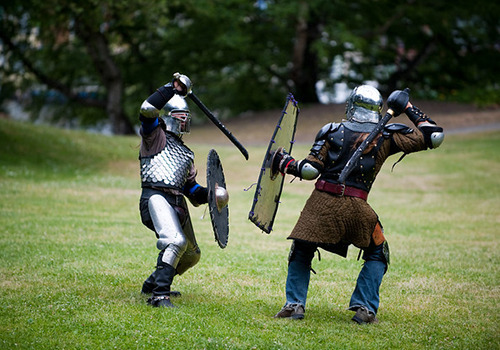
Writing a novel in a month doesn’t come naturally, but in this post, Municipal Liaison Naomi Nakashima, explores how following your instincts will propel your novel towards the finish line:
Most of what we think of as writing instincts, such as knowing which words will flow together better, how to structure a compelling story, and how to lay out plotlines that will draw in your readers, are actually well-learned, drilled-in skills. Skills that now come to us as second nature because we’ve done them for so long. It’s like muscle memory, or riding a bike: do it enough, and eventually you barely have to think about it.
In fact, a lot of what we tend to think of when we think of “writers’ instincts” are actually not instincts at all – at least, not by the traditional definition. An instinct is more than just doing something without having to think about it.
An instinct is an innate behavior that happens in response to certain stimuli. You don’t really have any control over the behavior - and most of the time you don’t even know where you learned it from. It’s a baby crying out when she’s hungry. Or the fear of spiders and snakes, even when there has been no previous interaction with either of these beings to explain that fear.
And, in writing, it’s the evolution of a story that has gone off the path of your plan.
If you spend a lot of time in any writing group, you’ll come across what might seem like a strange event: a writer whose characters have completely taken off with the story and made it their own. And, stranger still, you will hear writers talk about how these characters spoke to them, had a mind of their own, and went off to do things that the writer doesn’t quite know how to come back from.
It seems like a strange phenomenon because how can a creation surprise his or her author? Didn’t the author create the character’s backstory and personality? How can it be a surprise?
The truth is, this is what happens when you let go of the plans and let your instincts take over.
It’s writing a story about a male vampire slayer, and later learning that he was really a she, and she was a lesbian.
Typically, the stories born from these instincts are much more compelling than what the original plan would have been. That’s how they were able to pull the writer away from their plan. However, it can also be off-putting, especially if the story has veered too far off from the original outline and now have to find a way to get back on track.
But, what I’ve found is, once you allow your instincts to just take over your storytelling, once you allow your characters to take on a life of their own, everything flows much more easily.
You’re no longer stuck by the confines of your own personality and traits. Your characters will naturally grow into new personalities, free from your restrictions. And you’ll find it all easier to handle: what would they say? How would they react? What would they do next? All of these questions will get answered in a way that is true to the character and in less time than if you were overthinking and struggling to get them written.
November is the perfect time to practice turning off your inner-editor (that annoying voice that questions every word you write while you’re still writing) and let your instincts run the show for a bit. See what comes from that amazing mind of yours. I’m sure you’ll find that loosening the reins on one idea will make it easier for you to explore even more ideas.
Here’s what it all comes down to: you’re a great writer. You’ve spent years learning grammar and word usage. But you’re also a great storyteller: human beings are natural storytellers. It’s part of what has kept us alive for thousands of years. So trust those gut instincts when it comes time to sit and tell your story. Give your inner-editor a break in November and let your story flow.
You may have to bring your inner-editor back in December to clean up the words and grammar, but that’s its job. You have to get the story out first.
And that takes guts.

Naomi Nakashima is a long-time freelance ghostwriter and writing coach, and a 13 year NaNoWriMo veteran. Visit her website, or follow her on Twitter, Pinterest, or Instagram!
Top image licensed under Creative Commons from James Malone on Flickr.
September 23, 2019
The New NaNoWriMo Website Is Here!
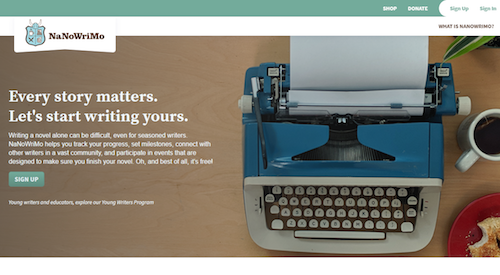
We’re incredibly excited to officially welcome you to our redesigned website. We were only able to do this with your support: your donations provided the resources, your ideas laid the foundation, and your enthusiasm provided the motivation to take this next, big step toward the future. It’s been a long journey and there’s still more to come… so we thank you for being such wonderful partners.
If you haven’t already, sign into the new site with your existing username and password!
What you should try first on the NaNoWriMo site:Customize your profile. We hope your personal space on the site feels more like yours than ever! Add a custom banner plate, display the stats you’re most proud of, and share your favorite books and authors.
In addition to your shiny donor halo, you’ll see a brand new set of laurels that commemorate your wins. The more wins under your belt, the longer your set of laurels will get:
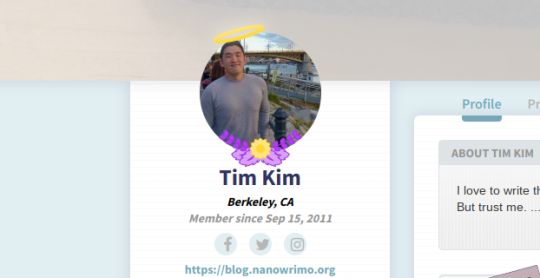
Announce the novel you’re planning to write this November. Go to “My NaNoWriMo” → “Projects”, then click “Announce New Project” to share details about your NaNoWriMo 2019 novel! (In the window that pops up, make sure to check “Associate with a NaNoWriMo event”.)
Some of y'all make gorgeous covers for your projects, so we’ve made sure you can show them off. Plus, click the cover to reveal the “back of your book” where you can share your summary and an excerpt:
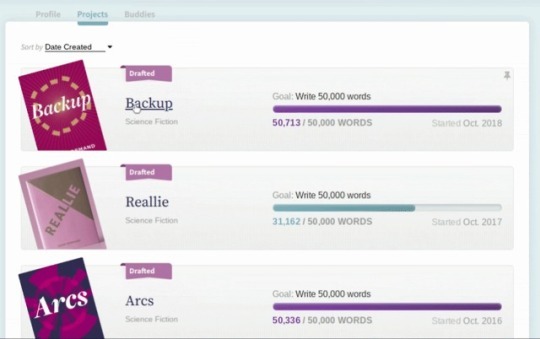
Discover your local writing community. Go to “Find a Region” to check out your local NaNoWriMo community. You can find out who your Municipal Liaisons are, chat with local writers, and join your regional forum.
You can also find in-person write-ins and meet-ups near you! Just go to your region and click the “Events” tab to scope them out and RSVP:
 How to get in touch with us
How to get in touch with usIf you have feedback or questions about the redesign, we’d love to hear it! We’ll be continuing work on the site all season long. You can share that in the Suggestions and Feedback forum. If something’s not working for you, please report those bugs in the Support and Tech Help forum. If you’re having issues with logging into the site, please email us.
September 20, 2019
Road Trip to NaNo: The Geography of Stories
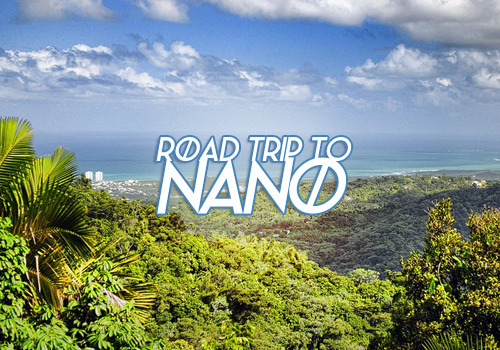
November is coming. To get ready, we’re taking a road trip to visit Wrimos from around the world, and hear about how their regions can inspire your writing. Today, Puerto Rico Municipal Liaison Amanda Rosa talks about how geography can influence your stories:
Greetings all the way from Puerto Rico. A small island in the Caribbean where you will find all kinds of landscapes. From a tropical rainforest, beaches everywhere, two of the five bio-luminescent bays in the world and I’m just starting. Puerto Rico is filled with colors, smells, sounds and taste in every corner that you visit.
It is no surprise, that through the years I have participated in NaNoWriMo, that Puerto Rico Wrimos are inspired by their surroundings when the time comes to write their novels.
Our characters take trips to the beach in December, get lost in El Yunque rainforest and then get abducted by aliens, and they get stuck in the first rain of May as good luck washes over them.
What I have come to learn from this is that our region takes notice of a character that many people forget about. It goes by a few different names like space, place or setting. I even go a little further and look at the whole Geography of my story.
When we think about Geography, we tend to think about the name of capitals, rivers, and maps but in reality, is much more. On my first day of college, I learned that a main part of Geography is the study of humans and their relationship with the space they occupy. And this has stuck with me through the years. Especially in my writing.
This is why I challenge you to think about the geography in your story. Where is your story taking place? What is the weather like? The sounds? The smells? How does your characters react to them? Do they like it? Or maybe they don’t.
Then think about how they react to liking or not liking it. Are they behaving the way they are because of the setting? If you move them to a different location, would the story be the same? How can the setting in your story move the plot along? Or is it dragging it? Or maybe they are doing an action that when you think about where the story takes place, it wouldn’t make sense.
Next time you sit down to write or maybe do an outline before November (which I recommend) really take a moment to ask these questions and more. Think about how your surroundings affect your everyday life and work that into your story.
I know I wouldn’t be the same person if I hadn’t been born in Puerto Rico. As I wouldn’t be writing the stories I do if I wasn’t influenced by my surroundings.
Amanda Rosa is a Municipal Liaison for the Puerto Rico Region and participant of NaNoWriMo since 2010. She enjoys writing fantasy, romance and Contemporary NA. She graduated from the University of Puerto Rico with a Geography major. She is currently working at a Law Firm. You can follow her on Twitter @mandylola.

Top image licensed under Creative Commons from Trish Hartmann on Flickr.
September 18, 2019
BRAVE THE PAGE Excerpt: Character Field Trips
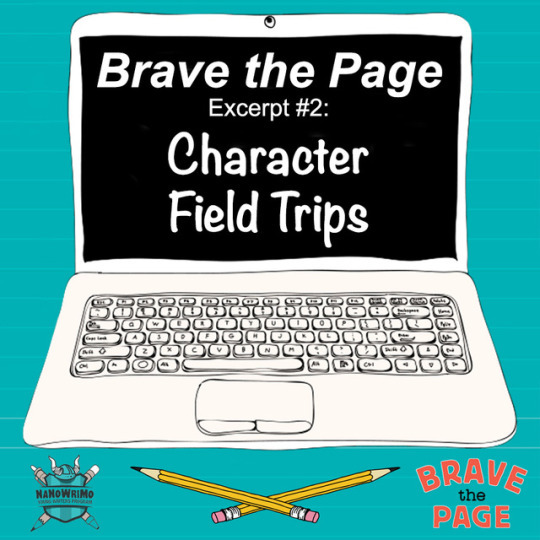
Brave the Page, our brand new NaNoWriMo handbook for young writers, is available to order! Partly a how-to guide on the nitty-gritty of writing, partly a collection of inspiration to set (and meet) ambitious goals, this is our go-to resource for middle-grade writers. Check out this Brave the Page excerpt on taking a character field trip:
To make your characters more believable, grab an invisibility cloak and a notebook and take a little field trip to study people in their natural habitats. You could sit in a crowded restaurant, walk around a shopping mall, or go for a ride on a bus. Wherever you end up, make sure you’re inconspicuous (that is, don’t be obvious; be sly like a spy). If you’re not able to get out of the house, turn the TV on and find a show where people are talking to each other. A reality show or talk show would work well.
In your notebook, jot down descriptions of the people around you. What do you see? What do you hear? Is someone slurping their soup or walking with a little skip in their step or scowling at the people around them? Do you see someone who’s broad-shouldered and tall like a football player, or someone who’s flowy and petite like a reed dancing in the wind? Take note of mannerisms (teenage girl nibbles on her nails as she reads her book), style choices (older man with a green spiky Mohawk is wearing a dark-blue business suit), and anything else unique or interesting that catches your eye.
Observing people and the way they interact with the world around them will help you develop believable characters across all genres. Even if your characters are 100-foot-tall cats or pint-sized purple dragons, you’ll want to incorporate human qualities into them or you’ll end up with a very confusing story.
Here are a few fun exercises from authors you can do to help develop your characters:
Watch the news, eavesdrop on the people at Trader Joe’s, go to all the parties. Your characters are out there, waiting to be discovered.
—Stacey Lee, award-winning author of Outrun the Moon
Write a long list of all your characters. Then, start drawing random lines connecting random characters to each other. Don’t think—just connect. Afterward, look down at your page. Try to figure out a connection between each of the two random characters you just linked—something scandalous, maybe, or something sweet. Something three-dimensional and unexpected. Some explosive scene that throws the two together.
—Marie Lu, New York Times bestselling author of the Legend trilogy
September 16, 2019
Meet Our New Interns, Nina and Freddy!

We feel super lucky here at NaNo HQ to be able to work with some excellent interns! Today, meet Programs Intern Nina Henry and Editorial Intern Freddy Cleveland, the newest additions to our team. You’ll be getting to know them better as a co-hosts of Virtual Write-Ins throughout November, but today they’re sharing a little bit about themselves:
From Freddy:This is me, two months ago:
I’m on a quest for gainful employment, and disappointed that every writing job I come across involves selling cushions for patio furniture, or editing people’s terrible resumes, or (ugh) harnessing big data to aid in the proliferation of targeted advertising. None of this is what I want to do.
And then comes an e-mail, inviting people to apply for an internship at… what’s this? NaNoWriMo. That thing I try to do every year! That thing that has been so influential on my life as a writer (even if I haven’t written anything non-academic in months). That thing I brought up in my college applications, where I talked about how writing a novel in a month (or at least, writing 50k words in 30 days) gave me good work ethic, taught me the value of perseverance, and contributed to my (eventual) academic success. Which, except maybe for the part about work ethic, is absolutely true.
I find myself leaping out of bed, lurching towards my computer. Now the terrible resume I have to edit is mine, and one thing leads to another, the resume leads to a phone call, which leads to an interview, and… wow, hello, everyone!
This is Freddy, speaking for the first time as the official holder of the very real and serious title Editorial Intern for Fall 2019. I’m excited to have the opportunity to work with National Novel Writing Month, an organization that has profoundly affected the course of my life. I can’t wait to get to work, and help make people’s novel-writing ambitions become having-written-a-novel realities. (Please imagine me giving you a big ol’ thumbs up and a well-deserved high five.)
I don’t have a cool sign-off, so please help me workshop the following potentials:
Stay frosty!
Let’s all be winners!
Keep writing!
Have fun!
From Nina:Hey writers! I’m the fabulous Nina Henry, and I am excited to join NaNoWriMo as the new Programs Intern.
I’m currently a student at San Francisco State University (last year!! :D) majoring in Communications Studies. I absolutely love reading and writing. I’ve always had a passion for creating things; I’m not the best with building physical sculptures, so I spend most of my time building literary sculptures. I’ve chiseled my way through five short stories, over 20 poems and songs, and a completed-but-still-in-the-editing-process novella.
I absolutely adore John Green novels (currently on Turtles All the Way Down). Nicholas Sparks is my usual go to for romantic novels, but I have a whole slew of authors whom I stand by for their literary excellence. Collectively they are my inspiration for many of my short stories and novel ideas. Additionally, I pull interesting stories from my own personal experiences, putting a twist on the outcome of situations in my life.
My biggest challenge in life is my procrastination. The dreaded time-waster is why a majority of the time I struggle with writer’s block. But journaling, reading, and music collectively aid me in my endeavors to continue writing. I always suggest it to anyone looking for a solution to a pestering, persistent problem.
I am a lover of words (if you couldn’t already tell) and am intrigued by any opportunity to indulge in my guilty pleasure—writing and grammaring (yes, I’ve made it a verb). I’m excited for the chance to work with a community so close to my heart (I’ve fan-girled over NaNoWriMo for years) and can’t wait to bring my love for writing to NaNoWriMo. This’ll be a great fall!
Chris Baty's Blog
- Chris Baty's profile
- 63 followers



